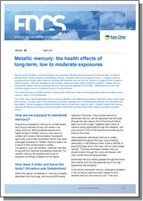What are the health consequences of long-term mercury exposure?
Currently in Europe less than one third of chlorine production is still based on mercury technology, with a view to phase this out completely by 2020. During this transition period, Euro Chlor contributes to ensure high workplace health standards based on research.
In the chlor-alkali industry elemental (metallic) mercury is used in the electrolysis of sodium chloride to make caustic soda and chlorine.
T here continues to be strong pressure from the regulatory bodies to remove mercury wherever possible from industrial uses and products. The Chlor-Alkali industry has committed to ending its use of mercury by 2020.
here continues to be strong pressure from the regulatory bodies to remove mercury wherever possible from industrial uses and products. The Chlor-Alkali industry has committed to ending its use of mercury by 2020.
The extent of the effects produced from exposure to metallic mercury will largely depend on the dose (how much), the duration (how long) and the route of exposure (how you came into contact with it).
Inhalations of elemental mercury over the longer-term may cause a variety of issues. At low to moderate dose levels, some effects can be observed but these are reversible once exposure is ceased. Levels of up to 50 µg/l in urine found no adverse effects in humans. Higher levels can lead to more serious problems.
Mercury is found widely in the environment, occurring both naturally and as a result of human activities. Globally, most of the mercury released into the environment by human activities is due to the burning of fossil fuels, waste incineration and gold mining.
Further information
Dolf van Wijk
Executive Director
Tel.: +32-2-676 73 70
Dirk Clotman
Communications Manager
Tel. +32-2-676 73 51
Editors notes
This is the sixth issue in a series of scientific publications called FOCS: Focus on Chlorine Science. Focus on Chlorine Science (FOCS) is a series of leaflets aiming to clarify and consolidate scientific research in the field of chlorine industry. With the FOCS series, we want to facilitate the knowledge gathering of scientists, regulators and key decision makers.
See more leaflets on the Euro Chlor science publications page
Have been published in this series:
Chlorinated swimming pools and respiratory health - March 2009
Electromagnetic fields in chlor-alkali production - Health effects and regulation - January 2009
Life Cycle Assessment - November 2006
Risk assessment and cycling of natural organochlorines - May 2006
Environmental fate and impact of chlorinated solvents - December 2005
Chlorination by-products - November 2005
